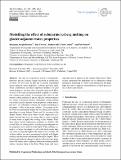Files in this item
Modelling the effect of submarine iceberg melting on glacier-adjacent water properties
Item metadata
| dc.contributor.author | Davison, Benjamin | |
| dc.contributor.author | Cowton, Tom | |
| dc.contributor.author | Sole, Andrew | |
| dc.contributor.author | Cottier, Finlo | |
| dc.contributor.author | Nienow, Pete | |
| dc.date.accessioned | 2022-04-08T15:30:58Z | |
| dc.date.available | 2022-04-08T15:30:58Z | |
| dc.date.issued | 2022-04-07 | |
| dc.identifier | 278789223 | |
| dc.identifier | d5ac0db4-d41c-45fb-82c7-8abfcb549d2a | |
| dc.identifier | 000778880200001 | |
| dc.identifier | 85128302281 | |
| dc.identifier.citation | Davison , B , Cowton , T , Sole , A , Cottier , F & Nienow , P 2022 , ' Modelling the effect of submarine iceberg melting on glacier-adjacent water properties ' , The Cryosphere , vol. 16 , no. 4 , pp. 1181–1196 . https://doi.org/10.5194/tc-16-1181-2022 | en |
| dc.identifier.issn | 1994-0416 | |
| dc.identifier.other | ORCID: /0000-0003-1668-7372/work/111210290 | |
| dc.identifier.other | ORCID: /0000-0001-9483-2956/work/111210307 | |
| dc.identifier.uri | https://hdl.handle.net/10023/25161 | |
| dc.description | Funding: This research has been supported by the Scottish Alliance for Geoscience, Environment and Society and the University of St Andrews (PhD studentship). | en |
| dc.description.abstract | The rate of ocean-driven retreat of Greenland's tidewater glaciers remains highly uncertain in predictions of future sea level rise, in part due to poorly constrained glacier-adjacent water properties. Icebergs and their meltwater contributions are likely important modifiers of fjord water properties, yet their effect is poorly understood. Here, we use a 3-D ocean circulation model, coupled to a submarine iceberg melt module, to investigate the effect of submarine iceberg melting on glacier-adjacent water properties in a range of idealised settings. Submarine iceberg melting can modify glacier-adjacent water properties in three principal ways: (1) substantial cooling and modest freshening in the upper ∼50 m of the water column; (2) warming of Polar Water at intermediate depths due to iceberg melt-induced upwelling of warm Atlantic Water and; (3) warming of the deeper Atlantic Water layer when vertical temperature gradients through this layer are steep (due to vertical mixing of warm water at depth) but cooling of the Atlantic Water layer when vertical temperature gradients are shallow. The overall effect of iceberg melt is to make glacier-adjacent water properties more uniform with depth. When icebergs extend to, or below, the depth of a sill at the fjord mouth, they can cause cooling throughout the entire water column. All of these effects are more pronounced in fjords with higher iceberg concentrations and deeper iceberg keel depths. These iceberg melt-induced changes to glacier-adjacent water properties will reduce rates of glacier submarine melting near the surface, increase them in the Polar Water layer, and cause typically modest impacts in the Atlantic Water layer. These results characterise the important role of submarine iceberg melting in modifying ice sheet-ocean interaction and highlight the need to improve representations of fjord processes in ice sheet scale models. | |
| dc.format.extent | 3120606 | |
| dc.language.iso | eng | |
| dc.relation.ispartof | The Cryosphere | en |
| dc.subject | GE Environmental Sciences | en |
| dc.subject | QE Geology | en |
| dc.subject | DAS | en |
| dc.subject.lcc | GE | en |
| dc.subject.lcc | QE | en |
| dc.title | Modelling the effect of submarine iceberg melting on glacier-adjacent water properties | en |
| dc.type | Journal article | en |
| dc.contributor.institution | University of St Andrews. Environmental Change Research Group | en |
| dc.contributor.institution | University of St Andrews. Bell-Edwards Geographic Data Institute | en |
| dc.contributor.institution | University of St Andrews. School of Geography & Sustainable Development | en |
| dc.identifier.doi | https://doi.org/10.5194/tc-16-1181-2022 | |
| dc.description.status | Peer reviewed | en |
This item appears in the following Collection(s)
Items in the St Andrews Research Repository are protected by copyright, with all rights reserved, unless otherwise indicated.

